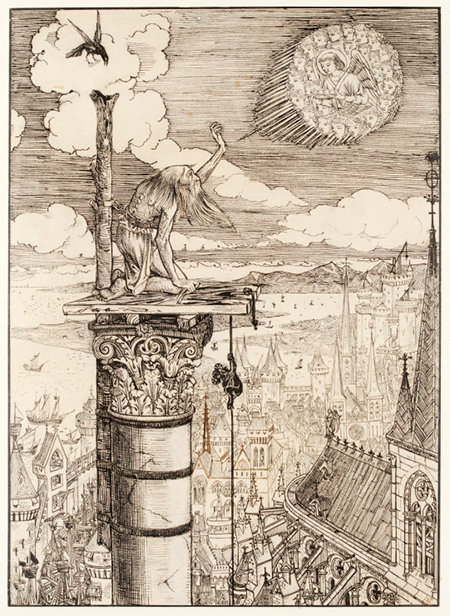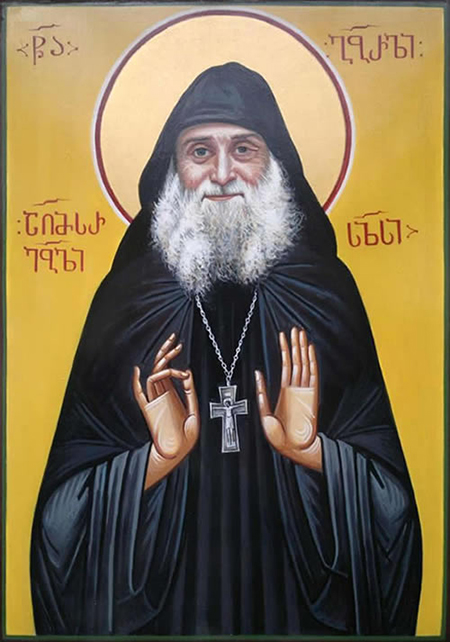| |
 |
 |
 |
| The story so far... |
 |
| You're currently on our features and projects pages, with material ranging from the satirical to the theological. For more features, click here. |
| |
|
|
 |
 |
 |
| In praise of holy fools |
 |
July is the month for holy fools. The feast of St Simeon the Holy Fool, who is the patron saint of this website, falls on 21 July. In celebration of that, Simon Jenkins muses on the holy fools of past and recent times, in a chapter from his book, Jumble Sales of the Apocalypse.
WESTERN CHRISTIANITY boasts some eccentric forms of religion, perhaps most famously the Pentecostal snake-handling churches of the Appalachian Mountains. Their favourite Bible verse isn't John 3:16, but the one where Jesus says in passing that his future followers would 'take up serpents' without harm. Unfortunately, the rattlesnakes they take to church don't hold the same interpretation of this proof text, with the result that quite a few believers have perished.
Snake-handlers aside, most of Western Christianity is an utter bore compared with the wild eccentricities of the Eastern church. Orthodox monks and nuns have lived up trees, in barrels, in bricked-up chapels or out in the fields grazing like sheep. St Simeon the Stylite started a craze among Syrian monks by balancing on top of a 50-foot pillar, drawing huge crowds and practising a kind of divine vertigo. He was so revered that even his blessed number twos, as they plopped off the pillar, were piously collected and turned into medallions for the faithful. Which only goes to show that you can polish a turd.

St Simeon Stylites, by William Burges, 1861
You'd think such extreme saints had reached the far end of austerity. But there was one final feat of mortification, and even the toughest men and women of the desert were in awe of it. It was the calling to be a fool for Christ. The first of these mavericks was another Syrian saint, Simeon the Holy Fool, who lived quietly as a monk in a Dead Sea cave for 29 years. But then one day he set out for the city of Emesa. He had decided to mock the idiocy of the world and convert sinners by becoming a public fool.
During church services, he pelted the clergy with nuts. In the circus, he wrapped his arms around the dancing girls and went skipping across the arena. In the streets, he tripped people up and dragged himself around on his buttocks. In the bath-house, he ran naked into the crowded women's section. On solemn fasting days he feasted riotously on beans, with predictable results. The locals saw him as a madman and beat him when his antics proved too much.
The tradition of fools for Christ really took off when it arrived in Russia. The Russian fools endured not only destitution and beatings, but also went naked in the cruel Russian winters. For them, being seen with a hot water bottle would have been as scandalous as the Archbishop of Canterbury being found in the bosom of a stripper.
Russia's most famous holy fool, St Basil, found his vocation in shoplifting, giving stolen goods to the poor and rebuking Tsar Ivan the Terrible for being a bit too terrible. In a sense, his mission of foolishness failed, because he ended up being buried honourably under the crazily colourful onion domes of St Basil's Cathedral in Red Square. In contrast, Rasputin, who is sometimes claimed as a holy fool (although he was actually an unholy scandal), ended up full of bullet holes and floating face down in a river, which would be a holy fool's dream ending. Rasputin had a reputation for healing and generosity to the poor, but also for heavy drinking and visiting brothels, and I only mention him because his story highlights the dangerous game genuine holy fools played with hypocrisy, masochism and actual madness.
Fools for Christ are rare in our time. At the height of the Cold War, St Gabriel the Holy Fool, a priest-monk from Tbilisi, Georgia, burned a giant portrait of Lenin during a Communist May Day parade. He was beaten by the crowd, tortured, sentenced to death and finally declared to be a psychopath. His response was to become a full-blown holy fool, masquerading as a drunkard and preaching loudly in the streets. Icons of St Gabriel, who died in 1995, show him smiling sweetly, which is a rare sight in the severe world of Orthodox icons.

Icon of St Gabriel the Holy Fool
If you were a bog standard monk or nun, you waved a fond farewell to home, family, shopping, cakes and sex. If you were an uber-saint like the stylites, you also said goodbye to the ground. But holy fools went even deeper into the spectrum, and found the ultra-violet of holiness as divine lunatics, outsiders and troublemakers. They added one more impossible thing to their vows of poverty, chastity and obedience, and that was humility to the point of humiliation.
A woman once found St Gabriel weeping in a church. He told her why: 'Christ was born in a manger, but people respect me and kiss me on the hand.' The favourite Bible verse of the holy fool is the one where St Paul says, 'We are fools for Christ'. Maybe the snake-handling Pentecostals could adopt it. But not just them, of course. Me too.
Image of St Simeon Stylies by William Burges: © Victoria and Albert Museum, London |
|
|
 |
 |
 |
| Simon Jenkins is the editor of Ship of Fools and author of Jumble Sales of the Apocalypse. Photo by Richard Hanson |
 |
 |
 |
| Jumble Sales of the Apocalypse is published by SPCK for £9.99 in paperback or e-book. |
 |
|
|
|
|


